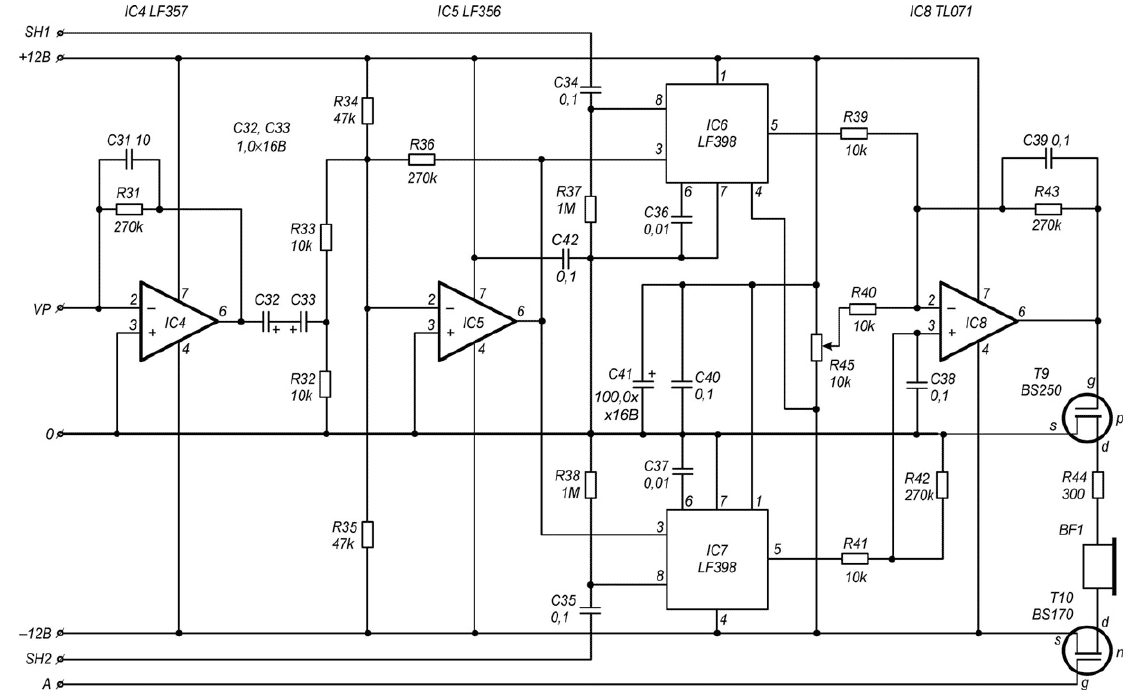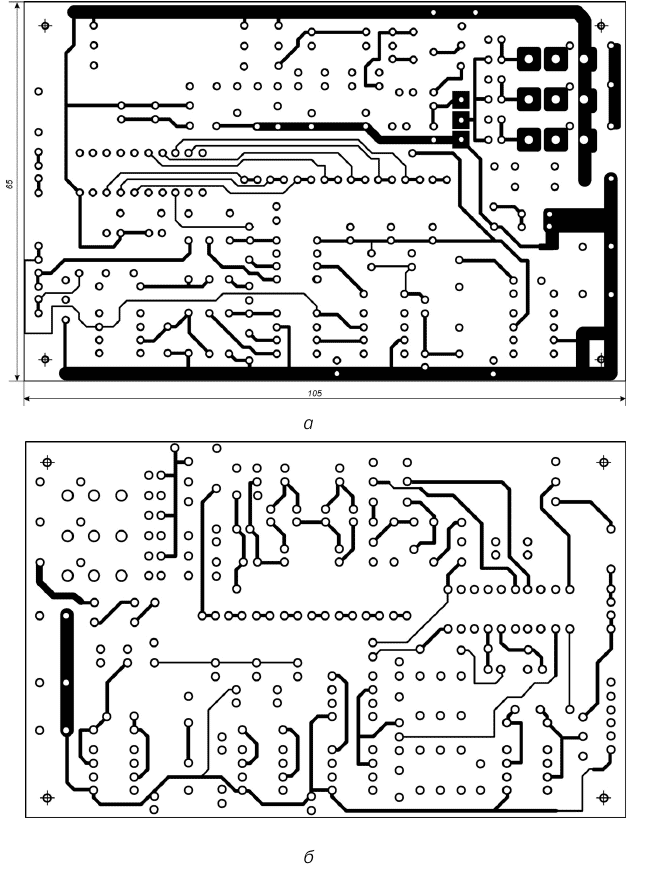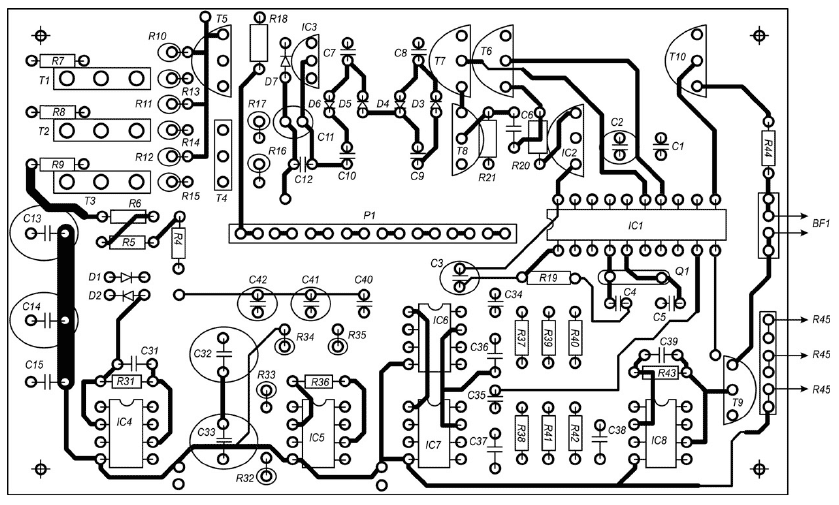Recently relatively widespread impulse metal detectors of the type PI (Pulse Induction) in which to assess the presence metal objects in the search area used is the phenomenon of occurrence of eddy surface currents in the metal object under the influence of external of the electromagnetic field.
In metal detectors type pulse signal PI is supplied to the transmitting coil, which is initiated by an alternating electromagnetic field. When in the area the action of this field metal object on its surface periodically, under the influence of the pulse signal, eddy currents. These currents are the secondary source signal, which is received by receiver coil. Thanks the phenomenon of self-induction form the secondary signal will differ from the form radiated by the transmitting coil of the pulse. In this case, differences in the parameters secondary pulse signal and are used for analysis, followed the formation data to the display unit. All known to the author of the pulse the detectors are evaluated changing the shape of the trailing edge of the secondary impulse.
In this device, a microprocessor is used with the appropriate software. Unfortunately, by the time of publication of this books to publish 100% working version of his firmware was not presented possible. So, interested and experienced readers have the opportunity test your hand at creating the firmware for the microcontroller. The author is not a second no doubt that the Russian craftsmen honored to do the task.
However, according to the author, the design of the proposed detector difficult enough to repeat novice Amateurs. You should also to mention the difficulties encountered when adjusting this device. Should be particularly pay attention to the fact that incorrect installation and incorrect instrument setup may cause failure of expensive elements.
Schematic diagram
A schematic diagram of a simple pulse detector conventionally can be divided into two parts, namely: the transmitter unit and the receiver unit. To unfortunately, the limited scope of this book does not allow you to dwell on all the features of the circuit design that was used to create this device. Therefore, the following explains the basic operation of only the most important knots and cascades.
The structure of the transmitter unit (Fig. 3.14) includes the module of generation of pulses and synchronization, the transmitter, and the voltage Converter.

Fig. 3.14. A schematic block diagram of a simple transmitter pulse metal detector (click to enlarge)
The main part of the whole structure is a module of generation of pulses and the synchronization is executed on the microprocessor IC1 type ATC ATMEL and ensuring the formation of pulses for the transmitter and signals governing the operation of all other units. Operating frequency of the microcontroller IC1 stable quartz resonator (3.5 MHz). When the specified value of the working the frequency of the microprocessor generates a periodic sequence of governors pulses for different stages of the detector. This sequence consists of 250 cycles with a duration of 9 μs each.
Initially the output of IC1/microprocessor 14 generates a control pulse for the transistor T6, after which the output of IC1/15 is formed a similar pulse to transistor T7. Then this process is repeated another time. The result is the launch of a voltage Converter.
Further, consistently on the findings IC1/8, IC1/7, IC1/6, IC1/16, IC1/17, IC1/19 and IC1/18 pulses start transmitter. These impulses have the same length, but each subsequent pulse detained relative to previous for a few cycles. The beginning of the first pulse, formed at the output of IC1/8, coincides with the end of the second pulse on the output of IC1/15. With the switch P1 is possible to choose the delay time of the pulse start the transmitter in relation to the start pulse.
After a few clock cycles after the end of the pulse at the output of IC1/18 short the gate pulse for one channel of the analyzer is formed on the output IC1/3. Then a similar impetus intended for the second channel analyzer, is formed at the output of IC1/9. After that, the output of IC1/11 generates a control signal for the transistor T10 schema acoustic alarm receiver unit. Then, after a short pause, the sequence of control pulses to the respective outputs of the microcontroller is formed again.
Supply voltage +5 V, previously stable chip IC2, is applied to the output of IC1/20 microcontroller.
Voltage Converter, transistors T6-T8 and the stabilizer IC3, provides for the formation of the bipolar supply voltage of 12 V, necessary to power the receiving part of the cascades. Control signals for transistors T7 and T8 are formed on the respective pins of the microcontroller IC1. In this case, the transistor T8 this signal is fed through the Converter level, assembled on the transistor T6. Next, the generated supply voltage stabilized chip IC3, the output of which a voltage of +12 V is supplied to the receiving part of the cascades.
Output stages of the transmitter are made on a powerful transistors T1, T2 and T3. to the total working load, which acts as a coil L1, shunted by a chain of resistors R1-R6. The operation of the output stage transistor controls the transistor T4. Control signal to the base of transistor T4 is supplied with the corresponding output of the processor IC1 through the transistor T5.
The momentum generated by the microprocessor IC1 in accordance with laid down in its the memory of the program, through the switch is input to the transistor T5 and forth, through the transistor T4, the output stages of the transmitter, which is made on the transistors T1-T3, and then transmitting coil L1. When the area of the coil L1 of a metal object on its surface under the influence of external electromagnetic field, initiated by the pulse the transmitter is energized eddy surface currents. The longevity of these currents depends on the duration of the pulse emitted by the coil L1.
In turn, the surface currents are the source of the secondary pulse signal with appropriate delay is accepted by the coil L1, is amplified and fed to the analysis scheme. It should be noted that thanks the phenomenon of self-induction the duration of the secondary signal will be greater than the duration of the light radiated by the transmitting coil of the pulse. The secondary form momentum depends on the properties of the metal from which is made is detected subject. Processing information about the differences of parameters of pulses emitted and adopted by the coil L1, provides for the formation data to the display unit on the presence of a metal object. In the present detector for analysis use the parameters of the trailing edge of the secondary pulse signal.
The structure of the receiver unit (Fig. 3.15) includes dual stage amplifier input signal analyzer and schema audible indication.

Fig. 3.15. Schematic diagram of the receiver unit simple pulse metal detector (click to enlarge)
The signal from a metal object is taken by the coil L1 and through the protection circuit, performed on the diodes D1 and D2 is fed to the input two-stage amplifier with capacitive feedback is made on operational amplifiers IC4 and IC5. With the output of chip IC5 (pin IC5/6) amplified pulse signal is fed to the schema analyzer performed on chips IC6-IC8.
Amplifiers IC6 and IC7 in the process of operation of the device is always off, and the voltage food is served only upon receipt to the corresponding inputs (pins IC6/8 and IC7/8) gate pulses, the duration of each of which is 9 μs (one cycle). In this case, the amplifier IC6 is served Gating the pulse delayed relative to the selected end of the trigger pulse transmitter for 30-100 μs, and the amplifier IC7 - delayed relative to the end of the first Gating pulse of 200 μs. The need for such the delay is due to the fact that the form of the received signal is affected by many extraneous factors, therefore, the useful signal can be observed only in the interval approximately 400 μs after the pulse. In this case the useful signal is the increase in positive the voltage at the approach of the coil L1 to a metal object in the result increasing the duration of the trailing edge of the secondary pulse in comparison with the radiated pulse.
After the supply voltage is connected to the outputs of each amplifier (chip IC6 and IC7) for a few seconds there remains a level of a received signal, recorded during the impact of Gating pulses. Thus on one of the inputs of the respective amplifier (pins IC6/3 and IC7/3) is adopted by a pulse signal and to the second input of the same amplifier (findings IC6/8 and IC7/8) through the capacitors C34 and C35 receives the appropriate the gate pulse module pulse-forming and timing (findings IC1/3 and IC1/9).
The signals generated at the outputs of circuits IC6 and IC7 (findings IC6/5 and IC7/5), further served to respective inputs of the differential amplifier, made on the chip IC8. The signal from the output of the amplifier IC6 goes through a variable resistor R45, which is the sensitivity device. If the area of the metal object detector the levels of signals at the respective inputs of the differential amplifier (pins IC8/2 and IC8/3) will be the same. As a result, the output signal of this amplifier (the output of IC8/6) will be low.
The voltage drop at the output of the amplifier IC8 leads to the discovery of the transistor T9 and to connect to a common wire headphones BF1. When applying with the corresponding output of the microcontroller (pin IC1/11) on the transistor T10 a control signal to the phone to listen to the audio signal. Resistor R44 limits the current flowing through the headphones BF1. It the selection you can adjust the volume of the acoustic signal.
The power of this metal detector is from the source B1 voltage 12 V.
Details and design
All the details of the proposed instrument (with the exception of the search coil L1, resistor R45, switch R1 and switch S1) located on the printed Board dimensions h mm (Fig. 3.16), made of two-sided foil Micarta or phenolic resin.

Fig. 3.16. The printed circuit Board simple pulse metal detector
To detail used in this device without facing any special requirements. It is recommended to use any small-sized capacitors and resistors that can be placed on a printed circuit Board (Fig. 3.17).

Fig. 3.17. The arrangement of the elements of a simple pulse detector
Chip type LF357 (IC4) can be replaced by LM318 or NE5534, but in the result of such a replacement can be problems with establishing. As amplifier IC5 in addition to those listed in the diagram of the chip type LF356 you can use IC CA3140. Chip type LF398 (IC6, IC7) can be replaced by MAC198. Instead of the amplifier CA3140 (IC8), you can use the TL071 chip.
As transistors T1-T3, in addition to those indicated on the schematic diagram, you can use type transistors BU2508, BU2515 or ST2408.
The working frequency of the crystal should be 3.5 MHz. However, you can to use any other crystal element with a resonance frequency from 2 MHz to 6 MHz.
For installation of microprocessor IC1, use a special socket. When this microcontroller is set to charge only once all installation works. This condition must be followed when carrying out adjusting operations related to soldering in the selection of values the individual elements.
Special attention should be given to the manufacture of the coil L1, the inductance of which shall be 500 mcg. Coil L1 is made in the form of a ring with a diameter of 250 mm and contains 30 turns of wire having a diameter of not more than 0.5 mm. When using wire a larger diameter coil current will increase, but will grow faster values of the parasitic eddy currents, resulting in deterioration of sensitivity device.
For the manufacture of coils is not recommended to use lacquered wire, since the potential difference between adjacent turns in the radiation pulse reaches 20 V. If in the process of winding turns of the coil will be next the conductors, for example the first and fifth windings, insulation breakdown almost provided. This can lead to failure of the transistors of the transmitter and other elements. Therefore, the wire used in the manufacture of the coil L1, must be at least in PVC insulation. The finished coil also recommended well to isolate. You can use epoxy resin or various foam fillers.
The coil L1 must be connected to the Board using double-well insulated wire, the diameter of each conductor which shall not be less than the diameter of the wire from which the coil itself is made. Not recommended use coaxial cable because of its greater capacity.
A source of audio signals can be either head phones with resistance from 8 to 32 Ohm small speaker with similar the resistance of the coil.
As the power source B1 is recommended to use rechargeable the battery capacity of about 2 hours, since the value of the current consumed data your detector is not less than 200 mA.
Printed circuit Board with the controls it contains and the power source are placed in any appropriate case. On the housing cover mounted AC resistor R45, the switch P1, connectors for headphones and BF1 coil L1 and a switch S1.
Establishing
This appliance should be set up in conditions when any metal objects removed from the search coil L1 at a distance of not less than 1.5 m. Feature settings and adjustments of the considered detector is that its individual modules and cascades are connected gradually. Each operation connection (soldering) is disabled the power source.
First you want to verify the existence and magnitude of the supply voltage on the corresponding socket contacts of the chip IC1 in the absence of the microcontroller. If the supply voltage is normal, then you should install on the Board the microprocessor and with the help of a frequency counter or oscilloscope to check the signal conclusions IC1/4 and IC1/5. The frequency of the pilot signal at these pins should to match the working frequency of use of the quartz resonator.
After connecting the transistors of the inverter voltage (no load) current consumption should increase by 50 mA. The voltage across the capacitor C10 in no load should be about 20 V. Then connect the stages of the transmitter. Modes of operation of the transistors T1-T4 must be the same and are set by selecting the values of resistors R13-R16.
The resistance of the coil L1 is shunted by the resistors R1-R3, should be approximately 500 Ohms. The conclusions of the coils and resistors should be well soldered, since the contact failure in this circuit entails the exit failure of the output transistors of the transmitter.
To test the functionality of the cascades transmitter, you can hold the coil L1 ear and turn the power of the detector. After about half a second (after reset of the microcontroller), you can hear the signal low tone, appearance which is due to the micro-vibration feedback of the individual turns of the coil. When this at the collectors of transistors T1-T3 will be generated unmodulated peaked pulse with a duration of about 10-20 μs, the form of which can check with an oscilloscope. The increase in the resistance of resistors R1-R3 leads to the increase of the amplitude of the output pulse with a decrease in its duration. For the selection of the resistance values of the shunt coil L1 is not it is recommended to use a variable resistor, because even a short the contact failure of the engine with the conductive track can cause failure of the output transistors of the transmitter. Therefore, it is desirable to gradually change the magnitude of the shunt with a step of 50 Ohms. Before replacing parts power supply unit must off.
Then you can begin to engage the receiving part. If all parts are serviceable, and the installation is made correctly, after the switching on of the detector (approximately 20 µs after the start of the pulse) at the output of chip IC4 (pin IC4/6) with an oscilloscope can be observed exponentially increasing signal, turning the signal level constant. Distortion of the front of the signal eliminated by choice of resistors R1-R3, santarosa coil L1. After that you should monitor the shape and amplitude of the signal at the output of chip IC5 (the output of IC5/6). The maximum amplitude of this signal is set by the selection value of the resistor R36.
At the output of the chip IC6 (pin IC6/5) should be generated constant signal, depending on the pulse selected by means of switch P1, and the availability of in the area of the coil L1 of metal objects. Ideally, this the signal should be close to zero for all positions of the switch P1.
In conclusion, it remains to properly set the position of an exemplary measuring pulse relative to the start pulse. It is enough selection quartz resonator Q1 to choose a suitable operating frequency.
The order of work
Prior to the practical use of this detector should switch P1 set the minimum delay of the pulse, and the resistor R45 - maximum sensitivity. If in the process of work in the area of the search coil L1 find yourself a metal object in the head phones will appear acoustic signal.
It should be noted that the transition in the mode of operation with a greater delay pulse will ensure the elimination of the influence of not only the magnetic properties of the soil, but also get rid the response of the device to various objects (rusty nails, foil from cigarette packs, etc.) and subsequent searches in vain.
Author: M. V. Adamenko






